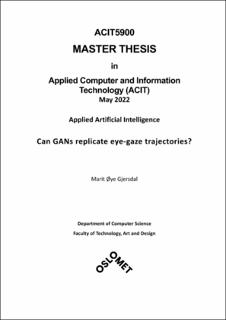| dc.description.abstract | Generative Adversarial Networks (GANs) have gained popularity in the field of computer vision. Recently, GANs have shown promising results in generating sequential data, such as time series data and text. This thesis explores the ability of a variety of time-series GAN architectures to generate realistic eye-gaze trajectory data, with the aim to create synthetic datasets for research within Machine Learning (ML) and statistics. The experiments were conducted in four stages, with increasingly more complex data for the GANs to generate, to study the limitations of each GAN model. The first experiments were done on synthetically generated data of Vector Autoregressive (VAR) processes and intermittent processes, and the final experiment was conducted on real eye-gaze trajectories. We show that even though several time-series GAN models are capable of generating seemingly realistic VAR processes and intermittent processes, there is still some way to go to be able to generate realistic eye-gaze trajectories. We discuss the limitations of a range of GAN models, and propose future experiments and models which could be further studied. | en_US |
